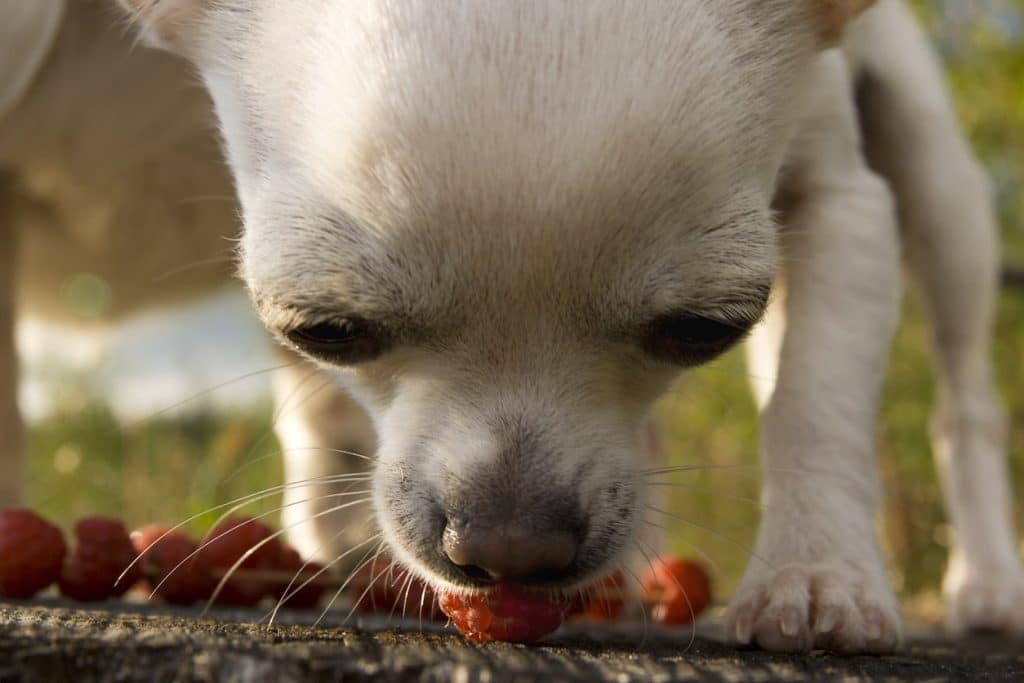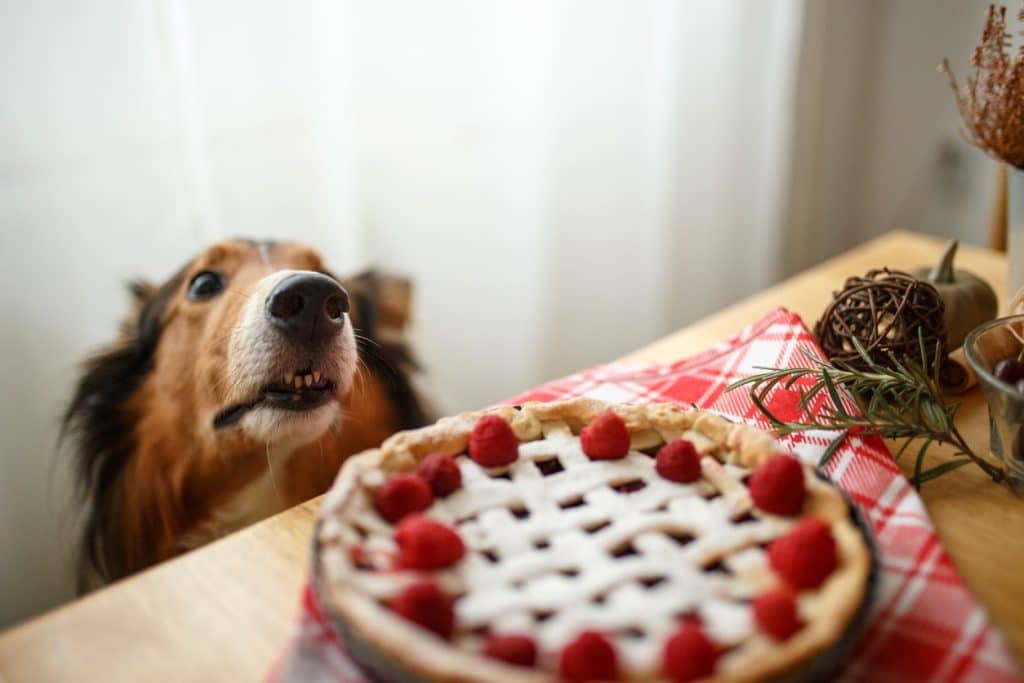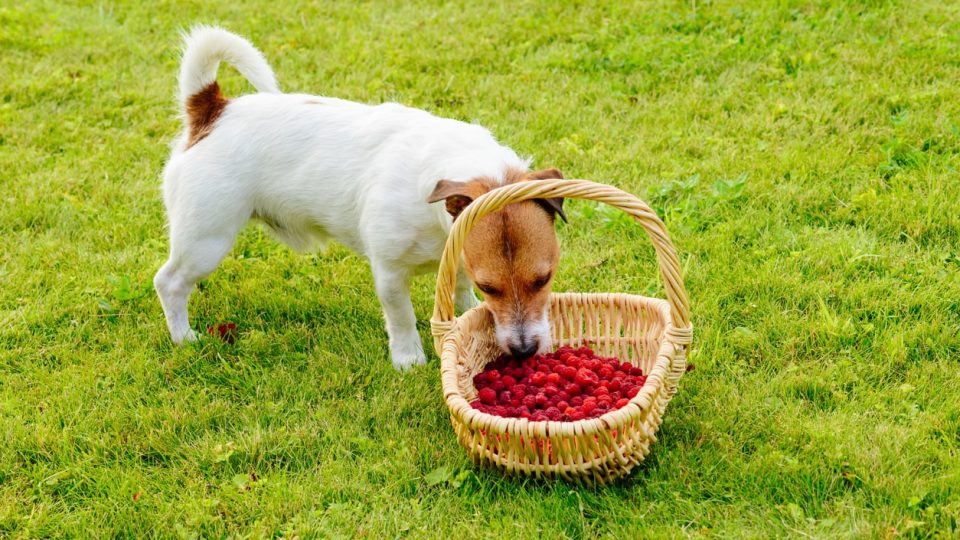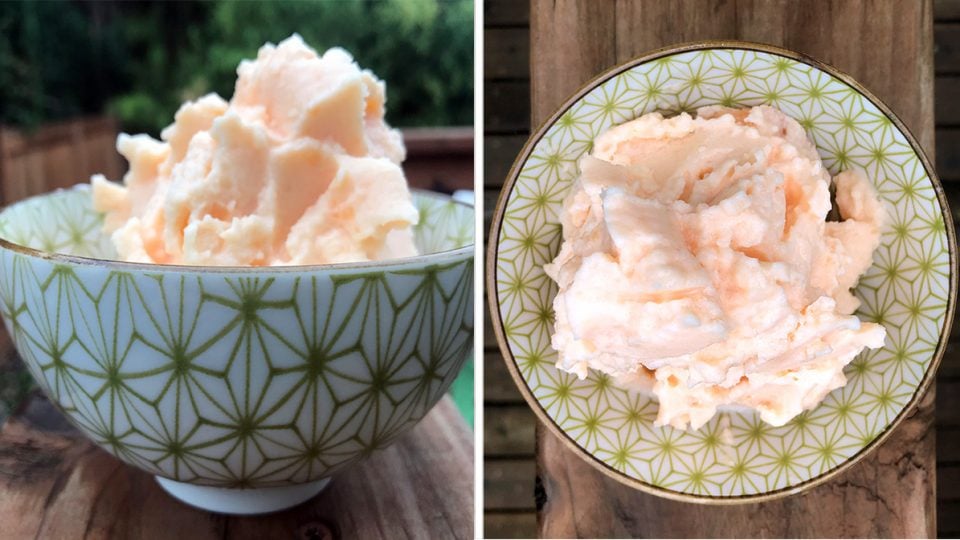- Not a substitute for professional veterinary help.
Raspberries are one of summer’s great pleasures. But should we be sharing these juicy gems with our pets? The short answer is yes! Dogs can eat raspberries in small amounts. As a “sometimes” snack, raspberries offer dogs a nutritional boost of vitamins, minerals, and fiber.
“In moderation, raspberries can be a great snack for dogs for their antioxidant properties and fiber content,” says Michael Thompson, DVM, founder and leading veterinarian of Pets Food Safety. “However, too many can lead to gastrointestinal upset due to high fiber content and naturally occurring xylitol,” he adds.
Here’s how dog parents can safely serve their pup raspberries and some tasty recipes too.
Can Dogs Eat The Whole Raspberry?
Fresh raspberries from the supermarket will usually contain two parts: the drupelets and the core. Drupelets are the individual juicy segments around the fruit’s exterior, and they are perfectly safe (and delicious) for dogs to enjoy. Sometimes you’ll come across a core, which is the central white part of the berry where the druplets attach.
“I tend to recommend avoiding the cores of all fruits to be safe,” says Dr. Deborah Linder, DVM, DACVN, a board-certified veterinary nutritionist at Cummings School of Veterinary Medicine at Tufts University. A raspberry’s core is usually harder and less palatable to dogs than the outside of the fruit. Like the leaves and stems of a strawberry, it can also present a choking or digestive hazard if too many are consumed.
As for jams, purees, and juices that contain raspberries, these do not make suitable treats for dogs because they contain too much sugar. Excessive sugar can cause a host of problems for dogs, including obesity, diabetes, and tooth decay.
What’s the Best Type of Raspberry To Feed My Dog?
Not all raspberries are equal. Dr. Thompson says fresh and unsweetened raspberries are the best option for dogs. “Their sugar content is lower compared to other methods like freeze-drying,” he explains. Fresh raspberries—along with fresh blueberries, blackberries, and strawberries—offer natural sweetness without loads of sugar.
As long as they’re unsweetened, frozen raspberries are another suitable option for dogs, says Dr. Sara Ochoa, DVM, a veterinarian at The Animal Hospital of West Monroe and co-founder of How To Pets. “They retain most of their nutritional value and can be a refreshing treat, especially during hot summer days,” she tells Rover.
While the freeze-drying process does tend to concentrate sugar content, freeze-dried berries can be a convenient substitute if they don’t contain added sugars or any artificial flavors. These should be offered sparingly, though.
If you’d like to treat your pup to some raspberries, the main thing to watch for is sugar and sweeteners. “I would use caution on commercial products that may have added sweeteners such as xylitol, which can be toxic to pets,” says Dr. Linder. Too much sugar, even the natural sugar found in raspberries, can lead to:
- Obesity
- Dental problems
- Diabetes
- Digestive upset: diarrhea, abdominal pain, and gas
- Pancreatitis (inflammation of the pancreas)
- A weakened immune system
- Hyperactivity
- Irritability

iStock/BBerit
What Are The Risks of Feeding My Dog Raspberries?
Along with sugar and fiber content, there’s one other component to watch for with raspberries: xylitol. A number of fruits and veggies contain naturally occurring xylitol, but raspberries have a higher amount than most.
While it’s safe for most mammals (including humans), xylitol is toxic to dogs. When ingested, this sweet substance is quickly absorbed into the bloodstream, triggering the release of insulin. This, in turn, can cause a serious drop in blood sugar or hypoglycemia. Xylitol poses the greatest risk to dogs when it’s used as a sugar substitute in things like sugar-free candy or peanut butter. But thankfully, the amount naturally present in fruit is pretty harmless.
“In good news, the amount of natural xylitol in raspberries is quite low,” Dr. Linder reassures. She says your dog would need to eat an enormous amount of raspberries to experience toxicity.
A study that looked at xylitol levels in different berries reported that one cup of fresh raspberries contains 0.05 grams of xylitol. A dog would have to ingest a dose higher than 0.1 grams of xylitol per kilogram of body weight to be at risk of hypoglycemia. Lastly, they would need to consume more than 0.5 grams per kilogram to develop liver failure.
To put this in perspective, it would take over 1 gram of xylitol to cause hypoglycemia in a dog weighing 10 kg (22 pounds). Meaning they’d have to scarf down a staggering 20 cups of raspberries for this to occur—upwards of 100 cups to cause liver failure!
How Many Raspberries Can I Feed My Dog?
For a balanced diet, treats should make up no more than 10% of your dog’s daily caloric intake. Every dog will have different calorie needs based on their size, activity level, and weight goals. On average, a 20-pound pooch needs roughly 325-400 calories per day—which means about 32-40 calories of treats is ok.
At just 1 calorie per berry, this fruit doesn’t exactly pack a huge calorie punch. Likewise, the concentration of xylitol in raspberries is not really cause for alarm. But even though raspberries are low in calories and considered non-toxic to dogs, Dr. Ochoa says servings should be on the smaller side. “The quantity of raspberries should still be monitored to prevent overconsumption or potential digestive issues,” she explains.
Just a few cups of raspberries (or any dog-friendly fruits or vegetables) can lead to an upset stomach, causing diarrhea, vomiting, or constipation. So even the largest dogs should be limited to 1/2 cup of raspberries at a time and only on occasion. Smaller dogs and puppies should stick to just a few berries at a time.
If your dog is a raspberry gobbler and you have raspberries growing in your yard, it’s best to keep an eye on them while the bush is fruiting and regularly remove ripe berries to avoid temptation.

iStock/Milan_Jovic
Serving Suggestions and Recipes
For the most part, raspberries are easy to feed your dog and don’t require much prep beyond thoroughly washing them. However, you may consider chopping or smashing them up to minimize the risk of choking. Dr. Ochoa explains some dogs face a higher risk of choking, including puppies, seniors, or dogs with dental issues.
For added flavor and nutrition, consider mixing in some healthy extras. “Raspberries can mesh well with unsalted, low-fat cottage cheese for a canine snack,” says Dr. Thompson. “The cheese provides additional protein, and its bland taste complements the raspberries’ sweetness.” Alternatively, Dr. Linder suggests loading a Kong or rubber puzzle toy with raspberries and water and then freezing it for a low-cal summer snack.
Looking for something more elaborate? Dr. Ochoa lays out the following dog-safe recipes that incorporate your summer berry haul.
Raspberry Chicken Salad
Ingredients:
- 1 cup cooked chicken breast, shredded
- 1/4 cup fresh raspberries, mashed
- 1/4 cup peas (cooked or thawed if frozen)
- 1/4 cup cooked quinoa or brown rice
Instructions:
- In a bowl, combine the shredded chicken, mashed raspberries, peas, and cooked quinoa or brown rice.
- Mix well until all the ingredients are evenly distributed.
- Serve as a meal topper or a standalone dish for your dog’s regular meals.
Frozen Raspberry Treats
Ingredients:
- 1 cup unsweetened applesauce
- 1/4 cup fresh raspberries
- Silicone mold or ice cube tray
Instructions:
- In a bowl, mix the unsweetened applesauce and fresh raspberries.
- Spoon the mixture into silicone molds or an ice cube tray.
- Freeze until solid.
- Pop out the frozen treats and store them in an airtight container in the freezer.
- Give them to your dog as a refreshing and healthy snack on hot days.
Dog-Friendly Cantaloupe Ice Cream
Add some fresh, freeze-dried, or frozen (unsweetened) raspberries to this tasty cantaloupe ice cream that you can share with your dog!
- Author: Based on a recipe by Kiki Kane
- Prep Time: 4 hours
- Cook Time: 28 minutes
- Total Time: 4 hours 28 minutes
- Yield: 2 cups
- Category: Summer Sweets
Ingredients:
- 2 cups (300g) frozen ripe cantaloupe
- 1/2 cup raspberries (fresh or frozen) or 1/4 cup freeze-dried raspberries
- 2 tbsp unsweetened yogurt
Equipment:
- Food processor or blender
- Freezer
Instructions:
- Make sure you have space for your cantaloupe in the freezer.
- Scrub the outside of the cantaloupe thoroughly.
- Slice the melon in half and remove seeds.
- Slice each half into quarters, remove the skin, then dice the fruit into bite-sized chunks.
- Place cut melon (and fresh raspberries) in the freezer. The more space around your melon chunks, the faster they will freeze, so if you’re in a rush, place pieces on a baking sheet to speed things up.
- When completely frozen (2-4 hours or overnight), place about 2 cups (300g) of melon pieces and 1/2 cup raspberries into the food processor.
- Add 2 tablespoons of unsweetened yogurt.
- Blend until combined, adding a little cool water if needed to blend to your preferred consistency.
Serving suggestions: Top your dog’s kibble with a few tablespoons, serve as part of dinner (replacing some of the usual food), or freeze into paw-shaped pops for the ultimate in homemade frozen dog treat goodness. We love these super-affordable dog-safe silicone molds.
Notes: If your dog is lactose intolerant, you can skip the yogurt, though it does change the consistency. A little peanut butter can work instead. (Watch out for xylitol in some brands of peanut butter!)
6 Other Fruits Your Dog Can Eat
If you’re looking to liven up your dog’s dish while providing a healthy boost, there are several dog-friendly fruits and veggies to consider. You can mash up a banana, slice up an apple, or even incorporate produce in a batch of homemade frozen treats. Maybe your dog would enjoy boiled sweet potatoes. Or perhaps, they’re more into watermelon or cantaloupe. When served in moderation, these tasty morsels are a great way to treat your pup and show them how much you love them.






